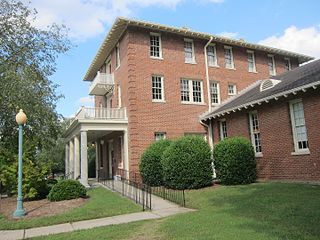
Drayton Hall is an 18th-century plantation located on the Ashley River about 15 miles (24 km) northwest of Charleston, South Carolina, and directly across the Ashley River from North Charleston, west of the Ashley in the Lowcountry. An outstanding example of Palladian architecture in North America and the only plantation house on the Ashley River to survive intact through both the Revolutionary and Civil wars, it is a National Historic Landmark.

The North Carolina State Capitol is the former seat of the legislature of the U.S. state of North Carolina which housed all of the state's government until 1888. The Supreme Court and State Library moved into a separate building in 1888, and the General Assembly moved into the State Legislative Building in 1963. Today, the governor and his immediate staff occupy offices on the first floor of the Capitol.

Claude and Starck was an architectural firm in Madison, Wisconsin, at the turn of the twentieth century. The firm was a partnership of Louis W. Claude (1868-1951) and Edward F. Starck (1868-1947). Established in 1896, the firm dissolved in 1928. The firm designed over 175 buildings in Madison.

Edenton Historic District is a national historic district located at Edenton, Chowan County, North Carolina. The district encompasses 342 contributing buildings, 4 contributing sites, and 3 contributing structures. It includes several buildings that are individually listed on the National Register. The Lane House, possibly the oldest surviving house in North Carolina, is owned by Steve and Linda Lane and is located within the district. Also located in the district are the Dixon-Powell House, William Leary House, and Louis Ziegler House designed by architect George Franklin Barber.

Rokeby is a Georgian house near Leesburg, Virginia, built in the mid-18th century. The house is the best example of Georgian architecture in Loudoun County. Rokeby served as a repository for U.S. Government documents during the British occupation and burning of Washington in 1814 during the War of 1812. The Declaration of Independence was reputedly kept in the basement.

William J. Wilkins was an American architect in Florence, South Carolina and in partnership with Joseph F. Leitner in Wilmington, North Carolina.
Louis H. Asbury (1877–1975) was an American architect, a leading architect of Charlotte, North Carolina. He is asserted to be the "first professionally trained, fulltime architect in North Carolina who was born and practiced in the state."
Leslie N. Boney Sr. (1880–1964) was an American architect who focused on schools. He designed approximately 1,000 schools or additions to schools, and his works appear in 51 of North Carolina's 100 counties.

Halifax Historic District is a national historic district located at Halifax, Halifax County, North Carolina, US that was listed on the National Register of Historic Places in 1970. It includes several buildings that are individually listed on the National Register. Halifax was the site of the signing of the Halifax Resolves on April 12, 1776, a set of resolutions of the North Carolina Provincial Congress which led to the United States Declaration of Independence gaining the support of North Carolina's delegates to the Second Continental Congress in that year.

A.S. Cooper Farm is a historic farm complex and national historic district located near Brownwood, Ashe County, North Carolina. The district encompasses 13 contributing buildings, 2 contributing sites, and 1 contributing structure. They are located in three primary clusters on the farm. The A.S. Cooper, Sr. cluster includes the A.S. Cooper, Sr. House, spring house, tool shed / wood shed, chicken coop, granary, and garage (1934). The second cluster is the barn / milking parlor, and silo complex. The third cluster includes the Albert Sidney Cooper, Jr. House (1918), small shed, kitchen building, shed, spring house, and barn. Associated with the complex is the family cemetery and agricultural landscape.

Walker's Inn is a historic building in rural Cherokee County, North Carolina. It is located at the northeast corner of the junction of SR 1505 and SR 1383 near Andrews. The house, appearing as a two-story five-bay frame house, was apparently built in stages, beginning c. 1844, after William Walker acquired the land on which it stands. The three rightmost bays of the house are a log structure, while the two on the left are a frame structure. The logs are partially exposed on the front, while most of the house is sheathed in board-and-batten siding. Windows are irregularly placed on the main facade. Long known as an inn, it sits along what was in the 19th century the major route between Franklin and Murphy. Frederick Law Olmsted stayed at the inn during his travels in the area in the late 19th century.

North Durham County Prison Camp, also known as Durham County Tuberculosis Sanatorium, is a historic prison and sanatorium located at Durham, Durham County, North Carolina. It was built in 1925, and is a three-story, "T"-shaped, Italianate style brick building. The building measures 232 feet long and has 17,000 square feet of floorspace. It features a three bay, Tuscan order portico in the Colonial Revival style. The building was originally constructed to serve as a prison facility. It housed a prison between 1925 and 1938, was converted for use as a tuberculosis sanatorium beginning in 1944 and continued this function until 1953. It then housed WTVD Television Corporation until 1979.

Clyde H. Ray Sr. House, also known as Ten Oaks and Breese House, is a historic home located at Waynesville, Haywood County, North Carolina. It was built in 1901–1902, and is a 2 1/2-story, Colonial Revival style frame dwelling with Queen Anne style design elements. It is sheathed in weatherboard and has a multi-gabled and hipped roof and two interior end brick chimneys. Also on the property is a contributing spring house.

Pine Crest Inn is a historic resort inn complex located in Tryon, Polk County, North Carolina. The inn and three of the ten cottages were built in 1906 as the Thermal Belt Sanatorium for tuberculosis care. The 2 1/2-story inn and 1 1/2-story cottages are Classical Revival style frame buildings that feature pedimented gables and attached one-story shed porches supported by Tuscan order columns. The remaining cottages were built after the conversion of the property to an inn in 1917. Four of the cottages were built by Pine Crest Inn developer Carter Brown, and two are historic log cabins moved to the property from the eastern Tennessee mountains.

Baker Sanatorium is a historic sanatorium in Lumberton, Robeson County, North Carolina. It was built in 1920–1921, and is a 3+1⁄2-story, five bay, "T"-shaped Mission Revival style brick building. The building features an arcaded porch, and the roofs are sheathed in terra cotta mission tiles. The hospital continued in operation until 1993. It has been converted to apartments.

West Main–North Chesnutt Streets Historic District is a national historic district located at Clinton, Sampson County, North Carolina. The district encompasses 44 contributing buildings in a predominantly residential section of Clinton. It developed between about 1830 to the early 1930s, and includes notable examples of Greek Revival, Colonial Revival, and Gothic Revival architecture. Notable buildings include the Richard Clinton Holmes House, Amma. F. Johnson House (1868), Dr. William G. Micks House (1851), William Hubbard House, R. H. Hubbard, Sr. House, St. Paul's Episcopal Church (1902), L. C. Graves Presbyterian Church (1908), C. B. Barrus House (1923), the Hathcock-Hobbs House, the Gabe Barbrey House (1932), and the F. L. Turlington House (1937).

William Breese Jr. House, also known as the Colonial Inn and the Inn at Brevard, is a historic home located at Brevard, Transylvania County, North Carolina. It was built about 1902, and is a two-story, Classical Revival style frame dwelling with a pebbledash finish and hipped roof. It has a two-story rear ell and features a central, two-story Ionic order entrance portico. It was converted for use as an inn and restaurant around 1955.

East Main Street Historic District is a national historic district located at Brevard, Transylvania County, North Carolina. It encompasses 14 contributing buildings, 1 contributing structure, and 1 contributing site in a predominantly residential section of Brevard. The district developed between about 1900 and 1959 and includes notable examples of Colonial Revival and Bungalow / American Craftsman style architecture. Located in the district are the separately listed St. Philip's Episcopal Church, Silvermont, William Breese, Jr., House, Charles E. Orr House, Royal and Louise Morrow House, and Max and Claire Brombacher House. Other notable buildings include the Lankford-Cleveland House, Brevard-Davidson River Presbyterian Church, White House, Wyke-Barclay House (1905), and Carrier-Plummer House (1914).

Woodard Family Rural Historic District is a national historic district located near Wilson, Wilson County, North Carolina. It encompasses 29 contributing buildings in a rural area near Wilson. The district developed between 1830 and 1911 and includes notable examples of Colonial Revival and Greek Revival style architecture. Notable buildings include the William Woodard House, the Woodard House, William Woodard Jr. House, and Elder William Woodard Sr. House.




















